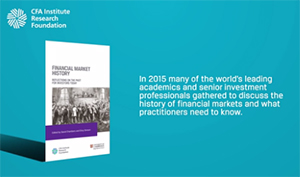What Can Investors Learn from Financial History That Will Help Them Today?
Since the 2008 financial crisis, there has been a resurgence of interest in economic and financial history among investment professionals. Practitioners and investors want to know whether history repeats itself and, if it does, what can we learn from it?
That was the question being asked at a workshop in July 2015 that brought together the collective knowledge of many of the world’s leading academics in the area of financial market history, as well as some 30 senior investment professionals, to discuss what investment practitioners need to know about financial history. Pulling together the wealth of information that was presented resulted in the recently released CFA Institute Research Foundation book Financial Market History: Reflections on the Past for Investors Today.
Old Issues, New Insights
Editors David Chambers and Elroy Dimson, academic leaders at the Newton Centre for Endowment Asset Management at the University of Cambridge in the United Kingdom, compiled contributions from 22 US and European financial historians, including Antti Ilmanen, Larry Neal, Christophe Spaenjers, and Caroline Fohlin. The book is arranged around four main sections — risk and return over the long run, stock markets, bubbles and crises, and financial innovation.
In the first section, chapters delve into the current state of academic research on the risk and return of such traditional assets as stocks, bonds, bills, and currencies, as well as such alternative assets as real estate, collectibles, precious metals, and diamonds. The next section includes meticulously detailed information about IPOs and trending investments in the wake of periodic cycles of market volatility, along with background on the growth and development of the earliest stock exchanges in Amsterdam, London, and New York. The third section discusses what we can learn from past market bubbles, which often lead to financial crises. The last section on innovation reveals just how long ago some financial innovations were introduced, such as the fact the elemental securities of structured finance first appeared two centuries ago.
The methods that financial historians use in the collection and construction of historical datasets provide new insights and in-depth learning as well as practical information for today’s investors. The takeaway is that the more reliable quantitative information about long-term returns and market activity that investors possess, the more informed their investment decisions will be.
Contributors Discuss the Book: Video Series
As the book was being pulled together, the CFA Institute Research Foundation interviewed each of the 12 contributors about their respective chapters. The result is a series of 3 to 10-minute videos available here.
The videos and more information are also available online at the CFA Institute Research Foundation or the Newton Centre for Endowment Asset Management at Cambridge Judge Business School for more information.
Be sure to read or download your free copy of Financial Market History: Reflections on the Past for Investors Today.
If you liked this post, consider subscribing to Market Integrity Insights.


To the extent that “”history repeats itself and, if it does, what can we learn from it?”” One common phrase which seems to show itself at times of whatever mania is occurring is “”This time it’s different!”” While it may be true that the components that comprise the makeup of a given market that eventually collapses may have changed, the outcomes are most assuredly the same: someone wins and someone loses. Perhaps the only items that are truly different is who is on which side.
It might be interesting to see, in the longer view of history, if some of the “”losers”” of the housing market collapse eventually became “”winners”” though the repricing of mortgage and real estate assets. By way of example, Fannie Mae and Freddie Mac were rescued by the taxpayers to the tune of $187 billion; that massive initial loss has now turned into massive profits, as the GSEs have repaid all of those funds plus an additional $68 billion. Also, banks and others paid hundreds of billions of dollars in fines that are or were (theoretically) being redistributed back into various forms and support for affordable housing. This wouldn’t have occurred otherwise. At some point, we’ll need to fully assess whether the repricing of housing and mortgage assets produced a collective net gain or loss.